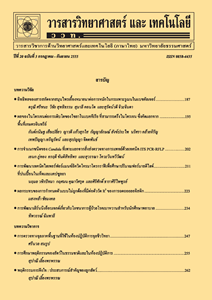การศึกษาชนิดของแบคทีเรียร่วมอาศัยในเพลี้ยจักจั่น Yamatotettix flavovittatus พาหะนำโรคใบขาวอ้อย
Main Article Content
Abstract
Abstract
The purpose of this study was to identify bacterial symbionts in the leafhopper Yamatotettix flavovittatus (Matsumura) vector SCWL disease for possible use in the insect population control. The result from 16S rRNA bacterial gene analysis was found two types of bacteria include Candidatus Sulcia muelleri which is primary symbiont that live in Bacteriome of suborder Auchenorrhyncha insect. Another type found belongs to Gammaproteobacteria which did not closely match with any sequences in the database and it was named “Unknown bacteria in Y. flavovittatus (UBYF)”. The Ca. Sulcia muelleri and UBYF are detected in natural population of the leafhopper at 80-100 % and found in all sampling sugarcane fields. Moreover, both of these bacteria found in all developmental stages including eggs, nymphs, and adults. We speculate UBYF is new type of primary symbiont that co-localize in Bacteriome with Ca. Sulcia muelleri and may be mutualistic relation with leafhopper Y. flavovittatus.
Keywords: leafhopper; Y. flavovittatus; primary symbiont; sugarcane white leaf disease
Article Details
References
[2] Aksoy, S., 1995, Wigglesworthia gen. nov. and Wiggleswothia glossinidia sp. nov., taxa consisting of the mycetocyte-associated, primary endosymbionts of tsetse flies, Int. J. Syst. Bacteriol. 45: 848-851.
[3] Wu, D., Daugherty, S.C., Van A.S.E., Pai, G.H., Dunbar, H.E. and Tran, P.L., 2006, Metabolic complementarity and genomics of the dual bacterial symbiosis of sharpshooter, PLoS. Biol. 4: 1079-1086.
[4] Dale, C. and Moran, N.A., 2006, Molecular interactions between bacterial symbionts and their hosts, Cell 126: 453-465.
[5] Montllor, C.B., Maxmen, A. and Purcell, A.H., 2002, Facultative bacterial endosymbionts benefit pea aphids Acyrthosiphon pisum under heat stress, Ecol. Entomol. 27: 189-195.
[6] Russell, J.A. and Moran, N.A., 2006, Costs and benefits of symbiont infection in aphids: Variation among symbionts and across temperatures, Proc. R. Soc. B. 273: 603-610.
[7] Lauzon, C.R., Sjogren, R.E. and Prokopy, R.J., 2000, Enzymatic capabilities of bacteria associated with apple maggot flies: A postulated role in attraction, J. Chem. Ecol. 26: 953-967.
[8] Beard, C.B., Mason, P.W., Aksoy, S., Tesh, R.B. and Richards, F.F., 1992, Transforma-tion of an insect symbiont and expression of a foreign gene in the Chagas disease vector Rhodnius prolixus, Am. J. Trop. Med. Hyg. 46: 195-200.
[9] Hanboonsong, Y., Choosai, C., Panyim, S. and Damak, S., 2002, Transovarial transmission of sugarcane white leaf phytoplasma in the insect vector Matsumuratettix hiroglyphicus (Matsu-mura), Insect. Mol. Biol. 11: 97-103.
[10] วรรณภา ฤทธิสนธิ์, 2547, การตรวจสอบแมลงพาหะนำโรคใบขาวออยและการถ่ายทอดโรคโดยเทคนิคทางชีวโมเลกุล, วิทยานิพนธ์ปริญญาโท, มหาวิทยาลัยขอนแกน, ขอนแก่น.
[11] Wangkeeree, J., Miller, T.A. and Hanboon-song, Y., 2012, Candidates for symbiotic control of sugarcane white leaf disease, Appl. Environ. Microbiol. 78: 6804-6811.
[12] Moran, N.A., Tran, P. and Gerardo, N.M., 2005, Symbiosis and insect diversification: An ancient symbiont of sap-feeding insects from the bacterial phylum bacteroidetes, Appl. Environ. Microbiol. 71: 8802-8810.
[13] McCutcheon, J.P. and Moran, N.A., 2010, Functional convergence in reduced genomes of bacterial symbionts spanning 200 my of evolution, Genome Biol. Evol. 2: 708-718.
[14] Noda, H., Watanabe, K., Kawai, S., Yukuhiro, F., Miyoshi, T. and Tomizawa, M., 2012, Bacteriome-associated endo-symbionts of the green rice leafhopper Nephotettix cincticeps (Hemiptera: Cicadellidae), Appl. Entomol. Zool. 47: 217-225.
[15] McCutcheon, J.P., McDonald, B.R. and Moran, N.A., 2009, Origin of an alternative genetic code in the extremely small and GC-rich genome of a bacterial symbiont, PLoS Genet. 5: 1-11.
[16] Gonella, E., Negri, I., Marzorati, M., Sacchi, M.L., Pajoro, M. and Daffonchio, D., 2011, Bacterial endosymbiont localization in Hyalesthes obsoletus, the insect vector of bois noir in Vitis vinifera, Appl. Environ. Microbiol. 77: 1423-1435.
[17] Baumann, P., 2005, Biology of bacteriocyte-associated endosymbionts of plant sap-sucking insect, Annu. Rev. Microbiol. 59: 155-189.

